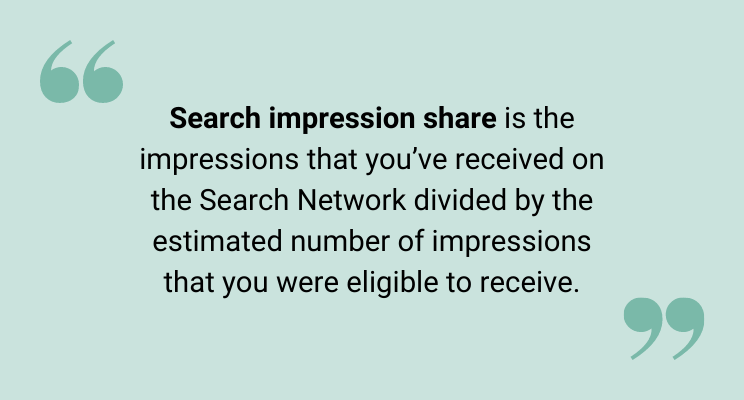


These metrics provide insight into how consumers interact with the website once they arrive.

If set up correctly, Google Analytics will provide page depth metrics for each ad group. Understanding what happens when consumers reach a website from a search engine marketing campaign is very important. (Google) Analytics Page Depth and Time-On-Siteĭefinition: How many pages consumers visit, and how long they stay on the website after clicking on a pay per click or search engine marketing ad. Realign budget from underperforming ad groups or increase the budget.Īlso, if you’re looking for an ideal impression share, we recommend a range between 30-80 percent.Ħ.
#IMPRESSION SHARE MEANING PRO#
Pro Tip: Look to increase impression share in performing ad groups. A 10 percent share also means that there is an opportunity to spend 80 to 90 percent more within the keyword groups. If the budget of the campaign is reporting a 10 percent impression share, then the pay per click ad is only showing or targeting 10 percent of the available impressions. Use impression share to understand scale within ad groups. the number of impressions available for purchase. Search Engine Marketing Ad Impression Shareĭefinition: The number of times your SEM or pay per click ad runs on a search engine vs. If the (campaign) cost per click is flat or is higher than average, there may be issues.ĥ. Pro Tip: A well-performing AdWords or search engine marketing campaign will show a decreased in cost per click (CPC) over time (3 months) compared to the published CPC averages. If over the average, there is a problem with ad copy or web page relevance. These numbers provide context and help advertisers understand how their campaign is performing. Search engines provide an average cost per click numbers per keyword category covering a 30-60 day period. The more businesses that bid on a keyword or phrase, the more companies will pay per click. Once identified, budgets can be realigned toward these words, which tends to result in a more successful campaign.ĭefinition: The cost charged by a search engine to the advertiser for a click on a search engine marketing ad.Ĭost- per-click represents the demand for a keyword or phrase. Pro Tip: Use keyword reports to identify keywords that directly produce engagement and conversions. Avoid targeting keywords such as “camping” without a qualifying term “trailer.” Consumers using the word camping within a search engine are most likely not searching for a camping trailer or RV. For example, an RV and camping trailer dealer should target consumers using keywords searching for camping trailers or RVs. Be aware of keywords that are broad and lack context. Use this report to understand what keywords or phrases are driving traffic to your website. Search Engine Marketing Keyword Reportĭefinition: The keywords or phrases searched within a search engine that results in a search engine marketing ad click (SEM or PPC). Website page design and messaging have a large impact on search engine marketing performance and cost.ģ. Pro Tip: If the traffic from your search engine marketing campaign (PPC) has little engagement and/or conversions, then consider auditing keywords (especially negatives), checking the geography where your ads are targeting, testing new ad copy, and upgrading the page(s) where the traffic is directed. When presented with click or website traffic numbers, recommend asking the following questions. So, make sure you are not gauging the success of the campaign specifically off of website traffic (click) numbers. Clicks or traffic to a website doesn’t necessarily indicate the consumer/traffic is interested in what the website is selling or attempting to communicate. This metric description is simple, but it’s important to note not all clicks or traffic to a website are created equal. Number of Clicks From the Search Engine Marketing Adsĭefinition: The number of times your search engine marketing ad is clicked on by a consumer. Pro Tip: Use impression-to-click ratios to optimize text and keywords within ad groups.Ģ. In summary, a better and more relevant the SEM campaign will have a low number of impressions. Google, for example, uses an impression-to-click ratio as part of a quality score metric, which dictates the cost per click and the rank of the ad on the search engine page. Most search engines penalize businesses that have high impression counts and a small number of clicks. The impression metrics within search engines aren’t necessarily a positive number. Search Engine Marketing Ad Impressionsĭefinition: The number times your search engine marketing ad is run or shown on a search engine marketing page.


 0 kommentar(er)
0 kommentar(er)
